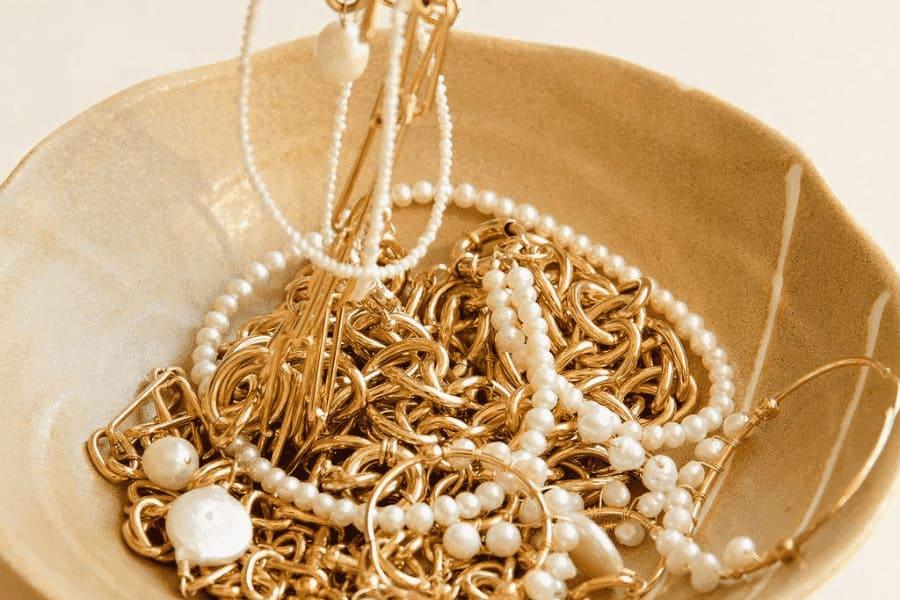Key Takeaways
- To differentiate real pearl necklaces from imitations, there are several helpful indicators such as luster, softness, irregularities, color, shape, weight and drill holes.
How to Recognize a Real Pearl Necklace
For centuries, pearls have been considered a precious gift that mother nature gives us. They are the symbol of elegance, chic and sophistication. But with the flood of many synthetic or imitation pearls, it is difficult for not only a seasoned connoisseur but also a novice to distinguish real pearl necklaces from fake ones.
How to recognize a real pearl necklace ? How to know if a pearl is real? We will give you some tips!
Touch and Feel the Temperature
The first answer to the question "how to recognize a real pearl necklace?" is the temperature when the pearl feels. Real pearls, especially those that are naturally grown, are normally cooler to the touch. It takes a little time for the pearls to warm up to the temperature of your skin. On the other hand, synthetic pearls are usually already at room temperature when you touch them.
This cool feeling could be a good trick to distinguish genuine pearls from imitation pearls. But remember to do this test under normal temperature conditions to get the most accurate results.

Genuine pearl necklace is cooler to the touch
Examine the Pearls
Examine each pearl in your necklace carefully. There are a few factors that determine whether pearls are genuine or not. Real pearls have a smooth surface and uniform texture. Also, the shape of real pearls, especially those that are naturally grown, are never perfectly round. The slightly irregular shape, on the other hand, gives the pearls a unique and authentic look.
Also, use a magnifying glass to examine the surface of each pearl in your necklace. Real pearls usually have some small flaws like bumps or ridges while fake pearls can look extremely perfect. If your necklace does not have these signs, it could not be authentic.
Alternatively, you can gently rub two pearls against each other in your hand. If they feel grainy, your necklace is probably an imitation.
Examine The Chandelier
The luster of the pearl is one of the important criteria to answer the question "How to recognize a real pearl necklace?". Genuine pearls catch the light distinctively, producing a subtle, deep sheen with an almost iridescent quality. It should appear almost shiny, with a mirror-like reflection. This shine is very difficult for others to imitate.
Additionally, genuine pearls often exhibit a variety of delicate shades in their color while imitation pearls exhibit a uniform, shallow luster without depth. So, to identify the authenticity of your pearl necklace, hold it up to natural light and observe it from different angles. If the pearls are dull or cloudy, they are likely fake. Also, if the surface of the pearls has visible flaking or discoloration, they are imitations.
Test the sweetness
Another way to check the authenticity of the pearl necklace is to test its softness or abrasion. You can gently slide two pearls against each other. With real pearls, this will create a fine powder, which is evidence of the existence of natural nacre. If you do this gently, the pearls are not damaged. On the other hand, fake pearls with a surface treated with synthetic materials cannot produce this powder.

Pearls on a necklace can have different shapes
Look for irregularities
When thinking about pearls, some people imagine that they are perfectly round objects. But in fact, pearls are not only not perfectly round but they also have irregularities. The surface of a genuine pearl is not smooth, there are probably small dimples. This is the structure of nacre and you can observe it with a magnifying glass. These irregularities determine the quality of the pearl and we can differentiate the types of pearls thanks to them.
So, carefully observe each pearl in your necklace. If they are perfectly round and their surface has no imperfections, the necklace is probably an imitation.
Assessing the Value of the Necklace
To answer the question "How do you know if pearls are real?", you need to assess their value. Pearls are rare and precious gemstones, so they have value. A genuine pearl necklace, whether natural or cultured, is more expensive than a fake. So, if you find the pearls look cheap, they are probably imitations. Or if someone is selling you a pearl necklace with a price that is too low, be careful because this offer is probably too good to be true.
Examine the color
Genuine pearls come in a variety of colors, such as classic white, pink, cream, silver, and even black. The pearls in a necklace may have nuanced variations. Additionally, real pearls, both natural and cultured, often have a nuance, a translucent color on their outer surface. You can see this clearly in high-quality pearls.
On the other hand, fake pearls do not have the criteria on them. Their color seems more uniform and lacks depth. But be careful that some real pearls do not have any nuance. So, this tip is not too reliable to recognize a real pearl necklace.

The pearls in a necklace can have nuanced variations
Observe the shape
The shape of pearls also tells us whether your pearl necklace is genuine or not. Real pearls have irregular shapes, such as oval, button, almost round, circled, coin-shaped, teardrop-shaped and baroque. This does not mean that there is no pearl that is perfect but perfection is directly proportional to its price. So, if you are offered a perfect pearl with a low price, beware!
Feel The Weight
Another tip to answer the question "How to tell if a pearl is real?" is its weight. Genuine pearls are usually heavier than fake ones. So, you can gently move your necklace up and down in your hand and feel the difference in weight. So, if the pearls in your necklace are too light, they could be synthetic ones.
Also, solid glass beads are the exception because they are heavier than natural and cultured ones. In this case, you have to use the other methods to differentiate.
Check the Drill Holes
The holes in pearls are also an important indicator to distinguish between real and synthetic pearls. Real pearls have drill holes that are usually small and blurry. If the holes are large and clear, they are probably imitation pearls.
In addition, the nacre of real pearls is usually not perfect with cracks. On the other hand, the coating around the holes of fake pearls is usually thin and looks like a glossy paint. Thus, the artificial nacre of fake pearls may flake off around the holes.

Real pearls have drill holes
Some Frequently Asked Questions
How to Know if Freshwater Pearls are Real?
Like other types of pearls, you can distinguish imitation freshwater pearls by using several simple tests. Freshwater pearls usually have an irregular shape, such as oval shapes. In addition, to identify the authenticity of freshwater pearls, tips like checking the luster, testing the texture by gently rubbing the pearls against each other, and observing the color. You can review the indicators mentioned above.
How to know if Tahitian pearls are real?
To differentiate imitation Tahitian pearls, you can pay attention to their surface and color. Tahitian pearls have several shades such as black, gray, blue or green. In addition, their luster is intense and deep. Authentic Tahitian pearls often have subtle multi-colored reflections and they reflect light well.
Also, look at the surface of Tahitian pearls. Authentic Tahitian pearls have small imperfections. Pearls with a perfect surface are very rare and very valuable.
At GitselB, we are sure that every pearl is authentic and carefully selected. Visit GitselB house now to discover our new collection!


